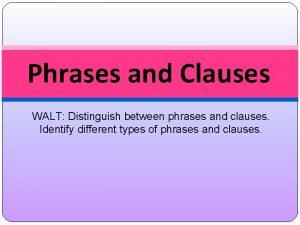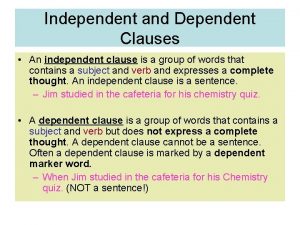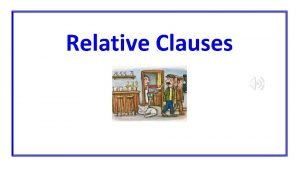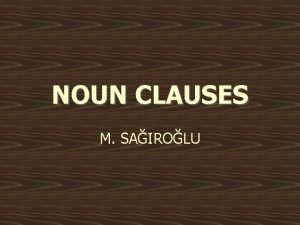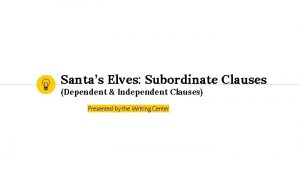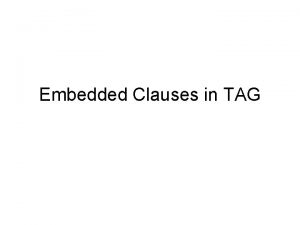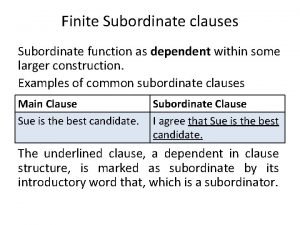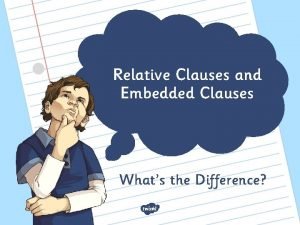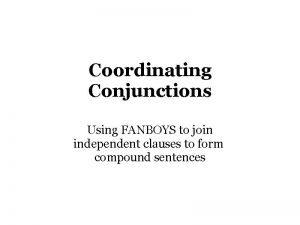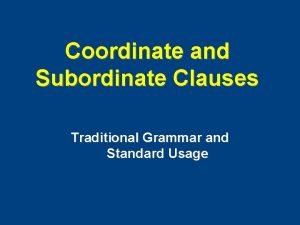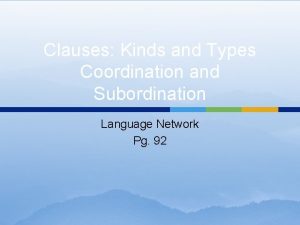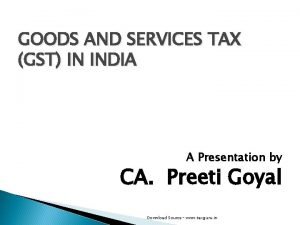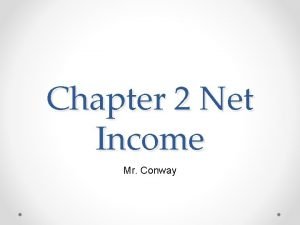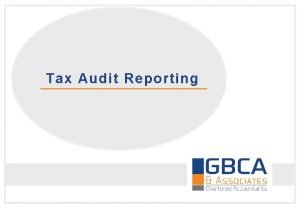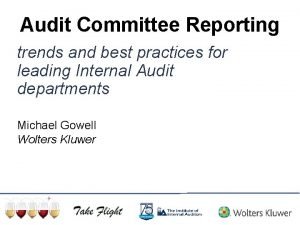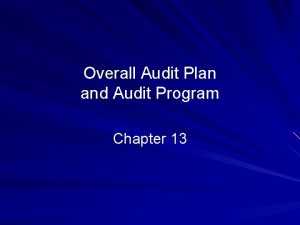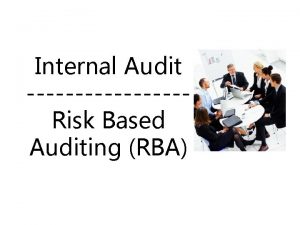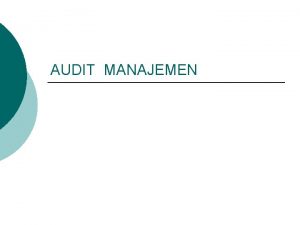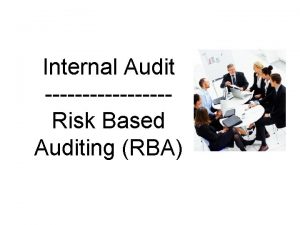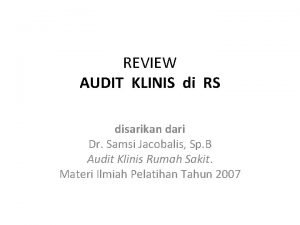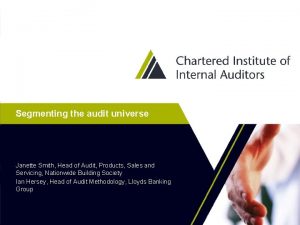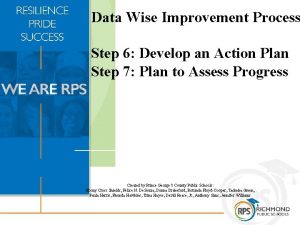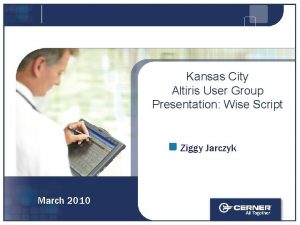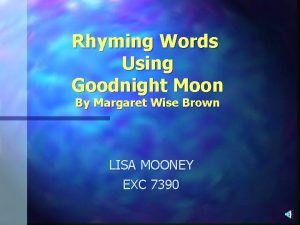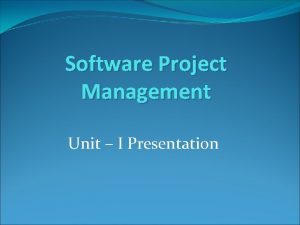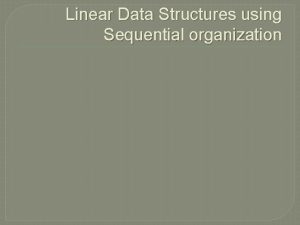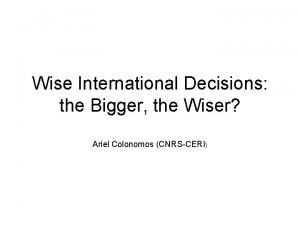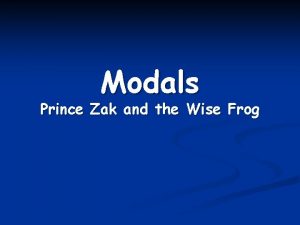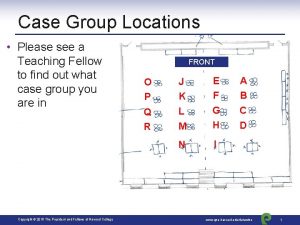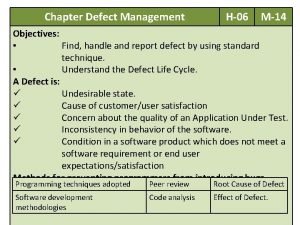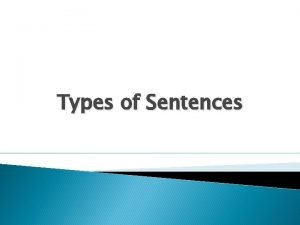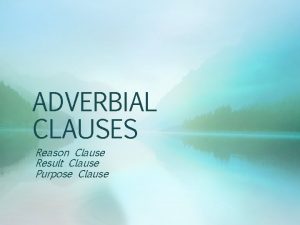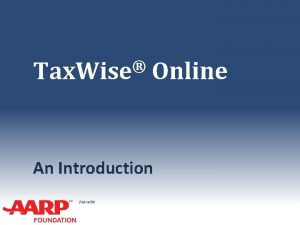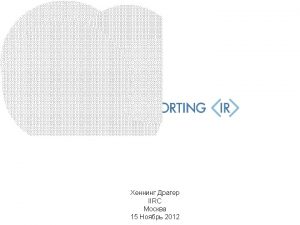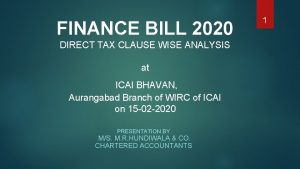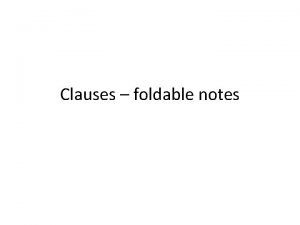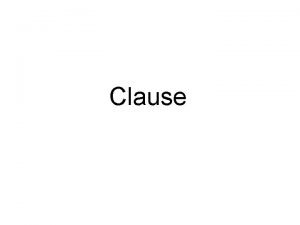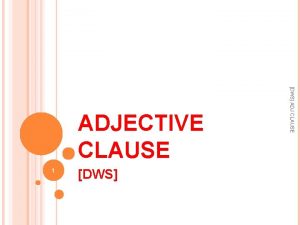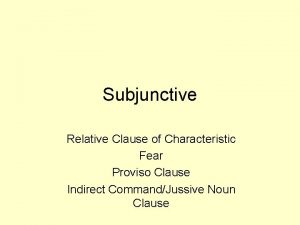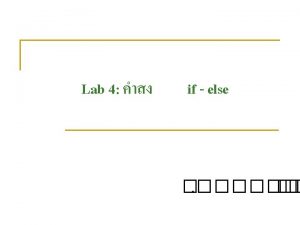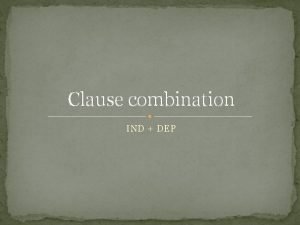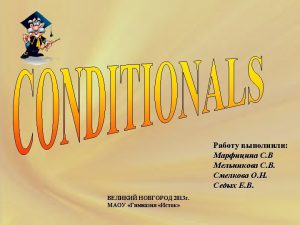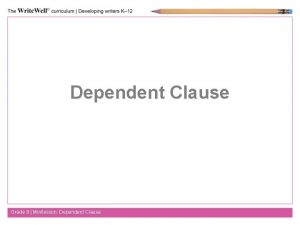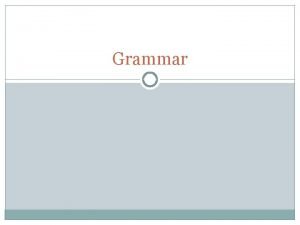Tax Audit Reporting Tax Audit Reporting CLAUSE WISE



























































- Slides: 59

Tax Audit Reporting

Tax Audit Reporting CLAUSE WISE DISCUSSION - Certain Important Clauses

Agenda Clause No. Particulars 15 Particulars of capital asset converted into stock in trade 16 Amounts not credited to Profit & Loss Account 17 Transfer of Land & Building at a value lesser than Stamp duty value 19 Amounts admissible as deductions from 32 AC to 35 E 20 Employee benefits 21 Admissibility of certain deductions 22 Amounts inadmissible under Section 23 MSMED Act, 2006 23 Payments to Related parties 26 Disallowance under section 43 B 28 Purchase of shares of company for inadequate consideration 29 Issue of shares at a price higher than the FMV 32 Details of brought forward loss or depreciation 36 Tax on distributed profits u/s 115 -O

Clause 15 : Particulars of capital asset converted into stock in trade Clause 15 Give the following particulars of Capital Asset converted into Stock in trade – • Description of Capital Asset [Sub clause (a)] • Date of Acquisition [Sub clause (b)] • Cost of Acquisition [Sub clause (c)] • Amount at which asset is converted into stock in trade. [Sub clause (d)]

Clause 15 : Particulars of capital asset converted into stock in trade For reporting under Clause 15, the following provisions need to be considered: 1) Section 2 (14) - Definition of capital asset: Ø Capital asset means property of any kind held by an assesse whether or not connected with his business or profession but does not include ; . i. Stock in trade, raw materials or consumable stores. ii. Personal effects of movable nature. iii. Rural agricultural land. iv. Gold deposit bonds. 2) Section 2(47) - Definition of transfer: Ø Transfer, in relation to capital asset, includes, inter alia, - conversion of capital asset into stock in trade of a business carried on by the assessee 3)Section 45 – Capital Gains: Ø Under sec 45(2) the capital gains arising from such conversion a capital asset into, or its treatment as stock-in-trade of a business shall be chargeable to income-tax as his income of the previous year in which such stock-in-trade is sold or otherwise transferred Ø Further, the fair market value of the asset on the date of such conversion or treatment shall be deemed to be the full value of the consideration

Clause 15 : Particulars of capital asset converted into stock in trade Matters to be considered: 1) Under sub-clause (c) the cost of acquisition is required to be reported. The cost of acquisition as per books of account is to be mentioned. While verifying the cost of . acquisition, principles enunciated in AS 10 should be borne in mind. 2) Under sub-clause (d) the amount recorded in the books of account at which asset is converted into stock-in-trade should be stated. The valuation is stock-in-trade is to be examined with reference to AS 2. 3) Non-compliance with AS 10 or As 2 is to be suitably reported in main audit report.

Clause 15 : Particulars of capital asset converted into stock in trade Matters to be considered: 4) To verify the basis of arriving the FMV and a suitable disclosure to be made, like – “During the year under consideration, a land admeasuring ___ is converted into . stock-in-trade and the fair market value of the same as on date of conversion is based on the valuation report obtained from ____” In such a case, compliance with SA 500 – Audit Evidence should be ensured.

Clause 16 : Amounts not credited to Profit & Loss Account Clause 16 Amounts not credited to profit and loss account being ; • Items falling within the scope of Section 28. [Sub clause (a)] • Pro forma credits, drawbacks, refund of customs or excise duties or service tax, sales tax or VAT, where the same are admitted as due by concerned authorities. [Sub clause(b)] • Escalation claimed during the previous year [Sub clause (c)] • Any other items of income. [Sub clause (d)] • Capital Receipt [Sub clause (e)]

Clause 16 : Amounts not credited to Profit & Loss Account lllustrative list of capital receipts not credited to Profit & Loss Account • Capital subsidy received in the form of government grants which are in the nature of promoters’ contribution. • Government grants related to specific fixed asset. • Compensation for surrender of rights. • Profit/loss on sale of fixed assets/investments to the extent not credited in the profit and loss account.

Clause 16 : Amounts not credited to Profit & Loss Account Matters to be considered: • Sub-clause (a): i. Section 28 shall also include any sum received for not carrying on any activity under an agreement in relation to any business or profession. (w. e. f. 01/04/2017) • Sub-clause (b): i. The words ‘admitted by the concerned authorities’ would mean ‘admitted within the relevant previous year’. However, if the assessee follows cash basis of accounting the admittance of claim without actual receipt will have no significance. • Sub-clause (c): Escalation Claims i. Where assessee follows cash basis of accounting, whether details of escalation claims accepted without actual receipt is to be reported?

Clause 16 : Amounts not credited to Profit & Loss Account Matters to be considered: ii. Whether the following escalation claims constitute claims accepted? • Claims merely made by the assessee • Claims under negotiations • Claims which are sub-judice (Ref: CIT v. Hindustan Housing & Land Development Trust Ltd. ) • Sub-clause (d): Any Other Income - i. Does ‘any other income’ include even ‘income from other sources’? ii. In case of incomes exempt for individuals, should the same be disclosed under ‘any other income’? • Sub-clause (e): Capital Receipt i. Does the phrase ‘Capital Receipts, if any’ includes capital contribution like gifts, share capital etc? ii. Should interest on Fixed Deposits or Other Incomes (like rentals) which are reduced from cost of fixed assets / Capital WIP be mentioned?

Clause 17 : Transfer of Land & Building at a value lesser than Stamp duty value Clause 17 Where any land building or both is transferred during the previous year for a consideration less than the value adopted or assessable by any authority of a State government referred to in Section 43 CA or 50 C. Details of Property Consideration received or accrued Value adopted or assessed/assessable

Clause 17 : Transfer of Land & Building at a value lesser than Stamp duty value For reporting under Clause 17, the following provisions need to be considered: 1) Section 43 CA - Special provision for full value of consideration for transfer of assets other than capital assets in certain cases: It is applicable where an asset (other than capital asset) being land or building or both has been transferred and the value of such an asset is less than the value adopted for the purpose of payment of stamp duty. The value so adopted shall be deemed to be the full value of consideration and the gain arising therefrom is taxable as business income. 2) Section 50 C - Special provision for full value of consideration in certain cases: It is applicable where a capital asset being land or building or both has been transferred and the value of such an asset is less than the value adopted for the purpose of payment of stamp duty. The value so adopted shall be deemed to be the full value of consideration and the gain arising therefrom is taxable as capital gain.

Clause 17 : Transfer of Land & Building at a value lesser than Stamp duty value Audit Considerations: • The auditor should obtain a list of all properties held and transferred during the year. The same should be verified from statement of profit and loss or Balance Sheet. • Amount of consideration received or accrued should be as disclosed in the books of account. • The auditor should also obtain a copy of registered sale deed for reporting the value adopted or assessable. • Where the property is not registered, the auditor may have to rely on third party experts like lawyer or solicitor representation. In such cases, compliance with SA 620 – Using the Work of an Auditor’s Expert needs to be kept in mind.

Clause 17 : Transfer of Land & Building at a value lesser than Stamp duty value Matters to be considered: • What should be the manner in which provisions of Section 43 CA is to be applied in case of builder adopting Percentage completion method for recognition of revenue ? • Whether the comparison of Stamp duty Value with Actual consideration for revenue recognition based on percentage completion method should be at each stage and for each year as on date of transfer or any other date ? • Whether leasehold right / development rights / TDR / FSI etc would be covered under this clause?

Clause 19 : Amounts admissible as deductions from 32 AC to 35 E Clause 19 Amounts admissible under sections: Section 32 AC 33 ABA 35 35 AC 35 AD 35 CCA 35 CCB 35 CCC 35 CCD 35 DDA 35 E Amount debited to profit and loss Account Amounts admissible as per the provisions of the income-tax Act, 1961 and also fulfils the conditions, if any specified under the relevant 14 provisions of Income-tax Act, 1961 or Income-tax Rules, 1962 or any other guidelines, circular, etc. , issued in this behalf.

Clause 19 : Amounts admissible as deductions from 32 AC to 35 E Audit Considerations: • The Tax Auditor should indicate the amount debited to the Profit & Loss Account and the amount actually admissible in accordance with the said sections. • The Tax Auditor should ensure eligibility of the expenditure/payment for deduction and compliance of conditions prescribed in the said sections. • The Amounts not debited to Profit & Loss Account but admissible under any sections mentioned in the clause have to be stated. [ Example : Section 33 AB and Section 33 ABA –Depositing amounts in designated accounts]

Clause 19 : Amounts admissible as deductions from 32 AC to 35 E Relevant Issues: • In case where audit is required under certain sections to claim deduction and separate auditor is appointed for this purpose, is it enough to rely on such auditor’s report ? • How will the auditor rely on the work done by such other auditors / experts for the work done by them? What should be the extent of reliance to be placed? • What would be the stand of a Tax Auditor in case such report is unavailable? • Where auditors have changed, can the auditor rely on previous year’s computation and audit report with respect to sec 35 D, 35 DDA etc or should scrutinize expenses incurred in earlier years?

Clause 20 : Employee benefits Clause 20 • Sum paid to employee as bonus or commission, where the same was payable as profits or dividend u/s. 36(1)(ii) [Sub clause (a)] • Sums received from employees as contributions to any provident fund or superannuation or any fund u/s. 2(24)(x) ; due date for payment & actual date of payment to concerned authorities u/s. 36(1)(va) [Sub clause (b)] Nature of Sum received Actual Fund from employees amount paid Due date for payment Actual date of payment to concerned authorities

Clause 20 : Employee benefit For reporting under Clause 20, the following provisions need to be considered: 1) Section 36(1)(ii) – provides for deduction of any sum paid to an employee as bonus / commission for services rendered where such sum would not have been otherwise payable to him as profit / dividend. 2) If bonus / commission is in the nature of profit / dividend, the same would not be allowable as a deduction and therefore, requires reporting under this clause. 3) Section 36(1)(va) – permits deduction of any sum received by the assessee from his employees to which provisions of sec 2(24)(x) are applicable, if it is credited to the account of employees on or before the due date. 4) Section 2(24)(x) includes within the scope of income any sum received by the assessee from his employees as contributions to any provident fund or superannuation fund or any fund set up under the provisions of the ESI Act, or any other fund for the welfare of such employees.

Clause 20 : Employee benefit Case Law In the case of CIT vs Gujarat State Road Transport Corp. , it was held by the Gujarat HC that the delayed remittance of employee’s contribution beyond due date prescribed in section 36(1)(va), is not deductible while computing business income, even though such remittance is made before due date of filing of return. In case of ITO 4(3)(3) vs. LKP Securities (ITA No. 638/Mum/2012) it was held that due date of payment of employees contribution to welfare funds was due date specified in respective Act governing the same and not due sate of filing return. Contrary View was taken in the following case laws : Ghatge Patil Transports Ltd [(2014) 368 ITR 0749 (Bom)] M/s Hindustan Organics Chemicals Ltd. [(2014) 107 DTR 0105 (Bom)]

Clause 20 : Employee benefit Audit Considerations: • The auditor should obtain a list of various contributions recovered from employees. The ledger account of contributions should also be reviewed. • The documents relating to provident fund and other welfare funds as well as agreements under which employees have to make contributions should be verified. • The auditor should maintain the details regarding nature of fund, amounts deducted, due date of payment, actual amount paid and actual date of payment in his working papers.

Clause 20 : Employee benefit Matters to be considered: • Is it mandatory to disclose that employers have not deducted/ collected Provident Funds from Employees ? • In case of Non-Corporate assessee following cash system of accounting , if provident fund contributions are deposited before end of relevant Previous year but remitted within statutory due dates, will the same be allowed as deductions? • How can a Tax Auditor verify the details of payments of Provident Fund etc. in Tax Audit of sub-contractor particularly when liability is on main employer? • As mentioned in the previous slide, different views have been taken by various courts as to the meaning of ‘due date’. A note specifying the reliance placed on any case law my be added to avoid ambiguity.

Clause 21 : Admissibility of certain deductions Clause 21 • Expenditure in nature of capital, personal, advertisement expenditure etc. [Sub clause (a)] • Amounts admissible under 40(a). [Sub clause (b)] • Amounts debited to Profit & Loss Account being interest, salary, bonus, commission or remuneration inadmissible under 40(b)/40(ba) [Sub clause (c)] • Disallowance under 40 A(3). [Sub clause (d)] • Provision for gratuity not allowed under 40 A(7). [Sub clause (e)] • Sums paid by an assessee as an employer not allowed under 40 A(9). [Sub clause (f)] • Particulars of contingent liability. [Sub clause (g)] • Amounts of deductions inadmissible in terms of Section 14 A [Sub clause (h)]. • Amounts inadmissible under proviso to 36(1)(iii) [Sub clause(i)]

Clause 21 : Admissibility of certain deductions a) Please furnish the details of amounts debited to the profit and loss account, being in the nature of capital, personal, advertisement expenditure etc. Nature Capital Expenditure Personal Expenditure Advertisement expenditure in any souvenir, brochure or the like published by a political party Expenditure incurred at clubs being cost for club services and facilities used. Expenditure by way of penalty or fine for violation of any law for the time being force Expenditure by way of any other penalty or fine not covered above Expenditure incurred for any purpose which is an offence or which is prohibited by law Sr. No. Particulars Amount in Rs.

Clause 21 : Admissibility of certain deductions Relevant Issues: • Capital expenditure is not defined in the Act and no conclusive test or rules can be laid down to determine whether an expenditure is capital / revenue. However, different tests have been applied by courts to decide whether the nature of expenditure is capital or not. • The Tax Auditor is not an expert to decide the nature of payment(as to whether it is prohibited by law or not ) and may not be aware about the intricacies of all the laws of the land. The Tax auditor should distinguish between compensation and penalty. Compensation are allowable business expenditure, whereas penalty is not. [Malwa Vanaspati & Chemical Co. v CIT]

Clause 21 : Admissibility of certain deductions b) Amounts admissible under 40(a): (i) As payment to non-resident referred to in sub clause (i) (A) Details of payment on which tax is not deducted (date of payment, amount of payment, nature of payment, name & address of payee) (B) Details of payment on which tax has been deducted but has not been paid during the previous year or in the subsequent year before the expiry of time prescribed under section 200(1) - (date of payment, amount of payment, nature of payment, name & address of payee, amount of tax deducted)

Clause 21 : Admissibility of certain deductions b) Amounts admissible under 40(a): (i) As payment to non-resident referred to in sub clause (i) (A) Details of payment on which tax is not deducted (date of payment, amount of payment, nature of payment, name & address of payee) (B) Details of payment on which tax has been deducted but has not been paid during the previous year or in the subsequent year before the expiry of time prescribed under section 200(1) - (date of payment, amount of payment, nature of payment, name & address of payee, amount of tax deducted)

Clause 21 : Admissibility of certain deductions b) Amounts admissible under 40(a): (ii) As payment to resident referred to in sub clause (ia) (A) Details of payment on which tax is not deducted (date of payment, amount of payment, nature of payment, name & address of payee) (B) Details of payment on which tax has been deducted but has not been paid during the previous year or in the subsequent year before the expiry of time prescribed under section 139(1)(date of payment, amount of payment, nature of payment, name & address of payee, amount of tax deducted, amount out of tax deducted, deposited, if any)

Clause 21 : Admissibility of certain deductions b) Amounts admissible under 40(a): (iii) under sub-clause (ic): sum paid on account of FBT (iv) under sub-clause (iia): sum paid on account of Wealth tax (v) under sub-clause (iib): amount paid by way of royalty, license fee, service fee, privilege fee, service charge or any other fee or charge, by whatever name called, which is levied exclusively on or which is appropriated, directly or; indirectly, from a SG undertaking by the SG. (vi) under sub-clause (iii): amount chargeable under the head “Salaries” payable outside india or to a non-resident (date of payment, amount of payment, name & address of the payee)

Clause 21 : Admissibility of certain deductions b) Amounts admissible under 40(a): (vii) under sub-clause (iv): payment to a provident or any other fund established for the benefit of employees of the assessee, unless the assessee has made effective arrangements to secure that tax shall be deducted at source from any payments made from the fund which are chargeable to tax under the head “Salaries” (viii) under sub-clause (v): any tax actually paid by an employer referred in clause (10 CC) of Section 10. to

Clause 21 : Admissibility of certain deductions c) Amounts debited to profit and loss account being, interest, salary, bonus, commission or remuneration inadmissible under section 40(b)/40(ba) and computation thereof; d) Disallowance/deemed income under section 40 A(3): (A) On the basis of the examination of books of account and other relevant documents/evidence, whether the expenditure covered under section 40 A(3) read with rule 6 DD were made by account payee cheque drawn on a bank or account payee bank draft. If not, please furnish the details (B) On the basis of the examination of books of account and other relevant documents/evidence, whether the payment referred to in section 40 A(3 A) read with rule 6 DD were made by account payee cheque drawn on a bank or account payee bank draft. If not, please furnish the details of amount deemed to be the profits and gains of business or profession under section 40 A (3 A);

Clause 21 : Admissibility of certain deductions e) provision for payment of gratuity not allowable under section 40 A(7); f) any sum paid by the assessee as an employer not allowable under section 40 A(9); g) particulars of any liability of a contingent nature; h) amount of deduction inadmissible in terms of section 14 A in respect of the expenditure incurred in relation to income which does not form part of the total income; i) amount inadmissible under the proviso to section 36(1)(iii)

Clause 21 : Admissibility of certain deductions Matters to be considered: • Capital expenditure is not defined in the Act and no conclusive test or rules can be laid down to determine whether an expenditure is capital / revenue. However, different tests have been applied by courts to decide whether the nature of expenditure is capital or not. • The Tax Auditor is not an expert to decide the nature of payment(as to whether it is prohibited by law or not ) and may not be aware about the intricacies of all the laws of the land. The Tax auditor should distinguish between compensation and penalty. Compensation are allowable business expenditure, whereas penalty is not. [Malwa Vanaspati & Chemical Co. v CIT] • Section 36(1)(iii) : While determining the allowability of interest should keep in mind the requirements of Accounting Standard 16 of Indian GAAP : Borrowing costs.

Clause 21 : Admissibility of certain deductions • Payments to non Residents Section 40(a)(ia) : Can we rely on CA certificate foreign remittances or should we decide for each and every foreign payment based on underlying documents/agreements ? • DCIT vs Chandabhoy & Jassabhoy , wherein it was held that provisions of section 40(a)(ia) can be invoked only in the event of non-deduction of tax at source but not for lesser deduction • Disallowance under section 14 A : While carrying out the examination of the details furnished by the assessee the tax auditor can rely on management representation letter. SA 580 on ‘Written representation’ may be referred to. • The Auditor should verify the list of cash payments. In respect of expenditure of more than Rs. 20, 000/- and should include list of payments exempted under Rule 6 DD.

Clause 22 : Amounts inadmissible under Section 23 Clause 22 Amount of interest inadmissible under Section 23 of Micro, Small & Medium Enterprise Development Act, 2006. Micro Enterprise • In case of enterprise engaged in manufacture or production of goods pertaining to any industry specified in SCH 1 ( Development and Regulations) Act 1951. Investment in plant and machinery does not exceed Rs. 25 lacs. • Incase of service enterprise, investment in equipment does not exceed Rs. 10 lacs.

Clause 22 : Amounts inadmissible under Section 23 Small Enterprise • Incase of enterprise engaged in manufacture or production of goods pertaining to any industry specified in SCH 1 ( Development and Regulations) Act 1951. Investment in plant and machinery exceeds Rs. 25 lacs but does not exceed Rs. 5 cr • Incase of service enterprise, investment in equipment exceeds 10 lacs but does not exceed Rs. 2 cr. Medium Enterprise • Incase of enterprise engaged in manufacture or production of goods pertaining to any industry specified in SCH 1 ( Development and Regulations) Act 1951. Investment in plant and machinery exceeds Rs. 5 cr but does not exceed Rs. 10 cr • Incase of service enterprise, investment in equipment exceeds 2 cr but does not exceed Rs. 5 cr.

Clause 22 : Amounts inadmissible under Section 23 • As per section 23 of MSME Act the interest payable or paid by the buyer, under or in accordance with provisions of Section 16 of the Act , shall not for the purpose of computation of income under Income Tax Act, 1961 be allowed as deduction.

Clause 22 : Amounts inadmissible under Section 23 Audit Considerations: • Where the auditor is issuing report in Form 3 CB, if no disclosure is made by the auditee in financial statements about the information as prescribed u/s 22 of MSME Act, an appropriate qualification in Form 3 CB should be given. • The auditor should obtain full list of suppliers which fall within the definition of ‘supplier’. It is the responsibility of the auditee to classify and identify the suppliers who are covered by this Act. The list so obtained shall be reviewed by the auditor. • Verify the interest paid or payable under section 16 of MSME Act from books of account on test check basis and obtain reasonable assurance of compliance.

Clause 22 : Amounts inadmissible under Section 23 Matters to be considered: • What would be the disallowance in case the auditor is liable to pay any interest under MSME Act but he has not provided the interest in his accounts? • In such a case, what would be the situation when he actually pays and claims such interest? • Where the auditor has relied on the auditee for classifying and identifying the suppliers covered under the MSME Act, 2006 whether a note explaining the reliance placed on auditee is enough to discharge the onus?

Clause 23 : Payments to Related parties Clause 23 Particulars of payments made to persons specified u/s. 40 A(2)(b) (i) Where the assessee is Persons referred to in clause (b) Individual any relative of the assessee; (ii) Company, firm, AOP, HUF any director, partner, or member or any relative of such director, partner or member; (iii) Carrying on business or profession any individual who has a substantial interest in the business or profession of the assessee, or any relative of such individual; (iv) Carrying on business or profession a company, firm, AOP or HUF having a substantial interest* in the business or profession of the assessee or any director, partner or member of such company, firm, AOP or HUF or any relative of such director, partner or member or any other company carrying on business or profession in which the first mentioned company has substantial interest*; (v) Carrying on business or profession (vi) Any person who carries on a All of the above business or profession a company, firm, AOP or HUF of which a director/ partner / member, has a substantial interest* in the business or profession of the assessee; or any director/ partner / member of such company, firm, AOP or HUF or any relative of such director, partner or member; *Substantial Interest : 20% or more voting power or share of profit of such business or profession.

Clause 23 : Payments to Related parties Matters to be considered: Whether payments made to related parties of capital nature are covered in reporting ? How can a tax auditor ascertain details regarding persons covered in the said section and how can such transactions be verified ? Transfer Pricing Domestic Transfer Pricing

Clause 26 : Disallowance under section 43 B Clause 26 In respect of any sum referred to in clause (a), (b), (c), (d), (e) or (f) of Section 43 B, the liability of which : A) Pre-existed on the 1 st day of the previous year but not allowed in the assessment of any previous year and was a) paid during the previous year b) not paid during the previous year. B) was incurred in the previous year and was a) paid on or before the due date for furnishing the return of income of the previous year under section 139(1). b) not paid on or before the aforesaid dates. (State whether sales tax, customs duty, excise duty or any other indirect tax, levy , cess, impost etc. is passed through profit and loss account)

Clause 26 : Disallowance under section 43 B Section 43 B - Certain deductions to be only on actual payment. The following amounts shall be allowed as deduction only in the previous year in which such amounts are actually paid: (a) any sum payable by way of tax, duty, cess or fee, by whatever name called, under any law for the time being in force, or (b) any sum payable as an employer by way of contribution to any provident fund or superannuation fund or gratuity fund or any other fund for the welfare of employees, or (c) any sum referred to in section 36(1)(ii), or (d) & (e) any sum payable as interest on any loan or borrowing from any public financial institution or a State financial corporation or a State industrial investment corporation, or a scheduled bank (f) any sum payable as an employer in lieu of any leave at the credit of his employee, shall be allowed (irrespective of the previous year in which the liability to pay such sum was incurred by the assessee according to the method of accounting regularly employed by him) only in computing the income referred to in section 28 of that previous year in which sum is actually paid by him

Clause 26 : Disallowance under section 43 B Matters to be considered: • Is Profession tax liability required to be reported under section 43 B ? • Where taxes, duties etc. referred to in Section 43 B are paid after tax audit is completed but before due date of filing returns, how should the same be dealt with by a Tax Auditor ?

Clause 28 : Purchase of shares of company for inadequate consideration Clause 28 Whether during the previous year the assessee has received any property, being share of a company not being a company in which the public are substantially interested, without consideration or for inadequate consideration as referred to in section 56(2)(viia), if yes, please furnish the details of the same. • Section 56(2)(viia) – provides that – where a firm or a company in which the public is not substantially interested, receives from any person or persons, any property, being shares of a company not being a company in which the public are substantially interested, — (i) without consideration, the aggregate FMV of which exceeds Rs. 50, 000, the whole of the aggregate FMV of such property; (ii) for a consideration which is less than the aggregate FMV of the property by an amount exceeding Rs. 50, 000, the aggregate FMV of such property as exceeds such consideration shall be chargeable to tax under the head Income from Other Sources. • Rule 11 UA provides the methodology for computation of FMV. The FMV of the shares has to be computed as per Rule 11 UA , irrespective of the market value of the shares transferred.

Clause 28 : Purchase of shares of company for inadequate consideration Audit Considerations: • This clause may also attract Standard on Auditing – 620 “Using the work of an Auditor’s expert” incase a valuation report is obtained to determine the FMV of the shares in case of unquoted instruments. • The Auditor should obtain a list containing the details of shares received and verify the same with the relevant documents and books of accounts. Such shares will be reflected in the books of accounts under “Investments” or “Stock in trade”. • When the shares are issued for no consideration, then the Tax Auditor can verify the same by share certificates, demat account statements etc. as the same will not be reflected in the books of accounts.

Clause 29 : Issue of shares at a price higher than the FMV Clause 29 Whether during the previous year the assessee received any consideration for issue of shares which exceeds the fair market value of the shares as referred to in section 56(2)(viib), if yes, please furnish the details • Section 56(2)(viib) – provides that - where a company, not being a company in which the public are substantially interested, receives, in any previous year, from any person being a resident, any consideration for issue of shares that exceeds the face value of such shares, the aggregate consideration received for such shares as exceeds the fair market value of the shares shall be chargeable to tax under the head Income from Other Sources. • Rule 11 UA provides the methodology for computation of FMV.

Clause 28 : Purchase of shares of company for inadequate consideration Audit Considerations: • The Auditor should obtain a list containing the details of shares issued to any person being a resident and verify the same with the relevant documents and books of accounts. • The following information should be maintained in the working papers: i. Name and status of person to whom shares have been issued ii. PAN of the person, if available iii. Nature of shares (Quoted in RSE / URSE / unquoted) iv. No. of shares issued v. Consideration received vi. Fair Market Value as per Rule 11 UA(1)(c) / 11 UA(2) vii. Face value of shares viii. Amount taxable u/s 56(2)(viib)

Clause 29 : Issue of shares at a price higher than the FMV Matters to be considered: • What would be the consequences if the company has issued shares to residents and non-residents under private placement at a price which is higher than the FMV of the shares ?

Clause 32 : Details of brought forward loss or depreciation Clause 32 • Details of brought forward loss or depreciation allowance, in following manner [Sub-Clause (a)]Serial No. Assessment Year Nature of Loss/ Allowance Amount as per return Amount as assessed Remarks • Where change in shareholding of company has taken place in P. Y due to which losses incurred in preceding P. Ys cannot be carried forward as per Section 79 [Sub-Clause (b)] • Whether the assessee has incurred any speculation loss referred to in section 73 during the previous year [Sub-Clause (c)]

Clause 32 : Details of brought forward loss or depreciation Clause 32 • Whether the assessee has incurred any loss referred to in section 73 A in respect of any specified business during the previous year. [Sub-Clause (d)] • In case of a company, please state that whether the company is deemed to be carrying on a speculation business as referred in explanation to section 73. [Sub. Clause (e)]

Clause 32 : Details of brought forward loss or depreciation For reporting under Clause 32, the following provisions need to be considered: • Brought forward losses may pertain to different heads of income such as property income, profits and gains in business or profession, speculation business or capital gains, the provisions of which are contained in sections 32 and 70 to 79. • Section 79 – provides that - where a change in shareholding has taken place in a previous year in the case of a company, not being a company in which the public are substantially interested, no loss shall be carried forward and set off against the income of the previous year unless— (a) on the last day of the previous year the shares of the company carrying not less than 51% of the voting power were beneficially held by persons who beneficially held shares of the company carrying not less 51% of the voting power on the last day of the year or years in which the loss was incurred • Section 73 – provides that any loss in respect of speculation business shall not be set off except against profits or gains of another speculation business • Section 73 A – provides that Any loss, computed in respect of any specified business referred to in section 35 AD shall not be set off except against profits and gains, if any, of any other specified business.

Clause 32 : Details of brought forward loss or depreciation Matters to be considered: • Where assessments are in various stages of litigation, is it correct to merely state ‘ information is not readily available and hence not furnished’? • Any assessment, rectification, revision or appeal proceedings pending at the time of tax audit have to be disclosed under remarks column under sub-clause (a). If orders are yet to be passed, the same can be disclosed along with impact thereof, if material.

Clause 36 : Tax on distributed profits u/s 115 -O Clause 36 In the case of domestic company, details of tax on distributed profits under section 115 -O in the following form: (a) Total amount of distributed profits (b) Amount of reduction as referred to in section 115 -O(1 A)(i) (c) Amount of reduction as referred to in section 115 -O(1 A)(ii) (d) Total tax paid thereon (e) Dates of payments with amounts

Clause 36 : Tax on distributed profits u/s 115 -O For reporting under Clause 36, the following provisions need to be considered: • Section 115 -O(1) – provides for levy of tax on dividends paid irrespective of whether dividend is paid out of current profits or accumulated profits in addition to the income-tax chargeable of a domestic company for any assessment year • Section 115 -O(1 A) - The amount referred to in sub-section (1) shall be reduced by, — (i) the amount of dividend, if any, received by the domestic company during the financial year, if such dividend is received from its subsidiary and, — (a) where such subsidiary is a domestic company, the subsidiary has paid the tax which is payable under this section on such dividend; or (b) where such subsidiary is a foreign company, the tax is payable by the domestic company under section 115 BBD on such dividend: (ii) the amount of dividend, if any, paid to any person for, or on behalf of, the New Pension System Trust referred to in clause (44) of section 10.

Clause 36 : Tax on distributed profits u/s 115 -O Audit Considerations: • Details of tax on dividend declared, distributed or paid during the Financial Year under audit i. e. F. Y. 2015 -16 should be reported. • The gross amount of dividend is to be reported in sub-clause (a) and the reduced amount is to be reported in sub-clause (b) and (c) • The tax auditor should keep working papers to reveal how the net amount has been arrived at. However, the tax auditor need not go into the question of how the total amount of distributed profits has been arrived at. • Information about the date of declaration/distribution of dividend or payment of dividend is not required to be given.

Clause 36 : Tax on distributed profits u/s 115 -O Calculation of dividend Amount of dividend Less: Amount of tax on dividend (Taxable @ 15%) Amount of outflow INR 100 INR 15 INR 85 Tax on dividend is on gross basis i. e. Amount of tax on dividend / Amount of outflow (15/85) = 17. 647% Tax on gross basis Add : Surcharge Add : Cess Effective Tax on Dividend 17. 647% 12% 3% 20. 357%

Clause 36 : Tax on distributed profits u/s 115 -O Matters to be considered: • How to report if dividend is declared for the relevant previous year after the tax audit is completed?
 He who walks with the wise grows wise
He who walks with the wise grows wise Does a subordinate clause make sense on its own
Does a subordinate clause make sense on its own Zero conditional правила
Zero conditional правила Independent marker word
Independent marker word Subordinate clause
Subordinate clause Subordinate clause это
Subordinate clause это Noun clause ve relative clause farkı
Noun clause ve relative clause farkı Warm adverb form
Warm adverb form If + simple present
If + simple present Main clause and subordinate clause
Main clause and subordinate clause Clause chart
Clause chart Four types of clauses
Four types of clauses If-clause and main clause
If-clause and main clause Finite subordinate clauses
Finite subordinate clauses Embedded clauses examples
Embedded clauses examples Independent clause fanboys independent clause
Independent clause fanboys independent clause Coordination in grammar
Coordination in grammar Independent dependent clause
Independent dependent clause Dependent and independent clause
Dependent and independent clause Classification of subordinate clause
Classification of subordinate clause Conclusion of gst
Conclusion of gst Ralphs annual income is about $32 000
Ralphs annual income is about $32 000 Reporting clause
Reporting clause Mike gowell
Mike gowell Penyelesaian audit dan tanggung jawab pasca audit
Penyelesaian audit dan tanggung jawab pasca audit Management audit
Management audit Overall audit plan
Overall audit plan Perbedaan audit konvensional dengan audit berbasis risiko
Perbedaan audit konvensional dengan audit berbasis risiko Konsep dasar audit manajemen
Konsep dasar audit manajemen Perbedaan audit konvensional dengan audit berbasis risiko
Perbedaan audit konvensional dengan audit berbasis risiko Audit informasi klinis adalah
Audit informasi klinis adalah The term audit organised from the latin word audit
The term audit organised from the latin word audit Perbedaan prosedur audit top-down dengan bottom-up
Perbedaan prosedur audit top-down dengan bottom-up Beda audit medis dan audit klinis
Beda audit medis dan audit klinis What is audit universe
What is audit universe Wiserobot
Wiserobot Datawise norms
Datawise norms Wise trading dutyfree shops
Wise trading dutyfree shops A wise man proportions his belief to the evidence
A wise man proportions his belief to the evidence Wise script
Wise script Unit 7 healthy and wise
Unit 7 healthy and wise Rhyming word for moon
Rhyming word for moon Wise mind handout
Wise mind handout Step wise project planning
Step wise project planning Acp journal wise
Acp journal wise Fox eyes margaret wise brown
Fox eyes margaret wise brown Wise work and travel
Wise work and travel A wise man seeks counsel
A wise man seeks counsel Row major wise formula
Row major wise formula You better wise up janet weiss
You better wise up janet weiss Ariel wise
Ariel wise Wise men gifts
Wise men gifts Literal language vs figurative language
Literal language vs figurative language Stupid sunbathers nfl team
Stupid sunbathers nfl team Hptv
Hptv English proverbs
English proverbs Wise-4051
Wise-4051 Prince zak and the wise frog
Prince zak and the wise frog Data wise swoosh
Data wise swoosh Estimate expected impact of a defect
Estimate expected impact of a defect

